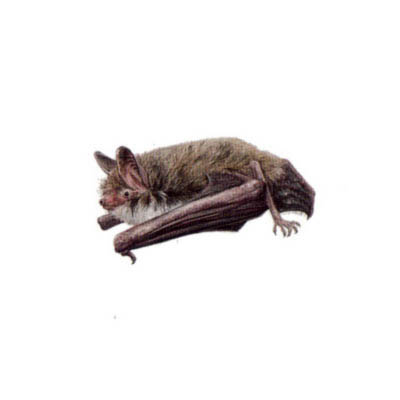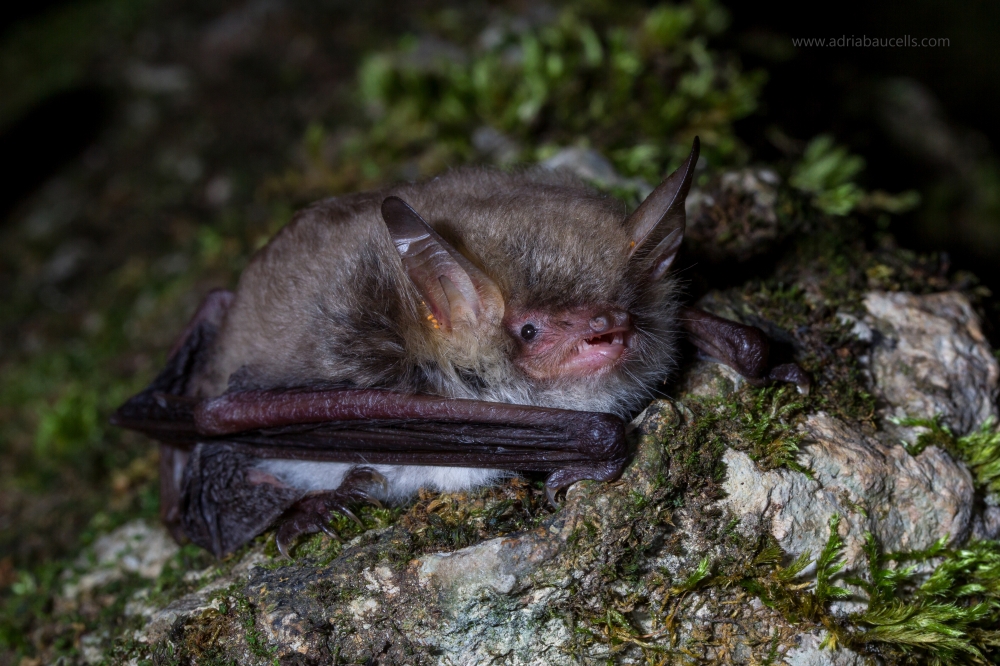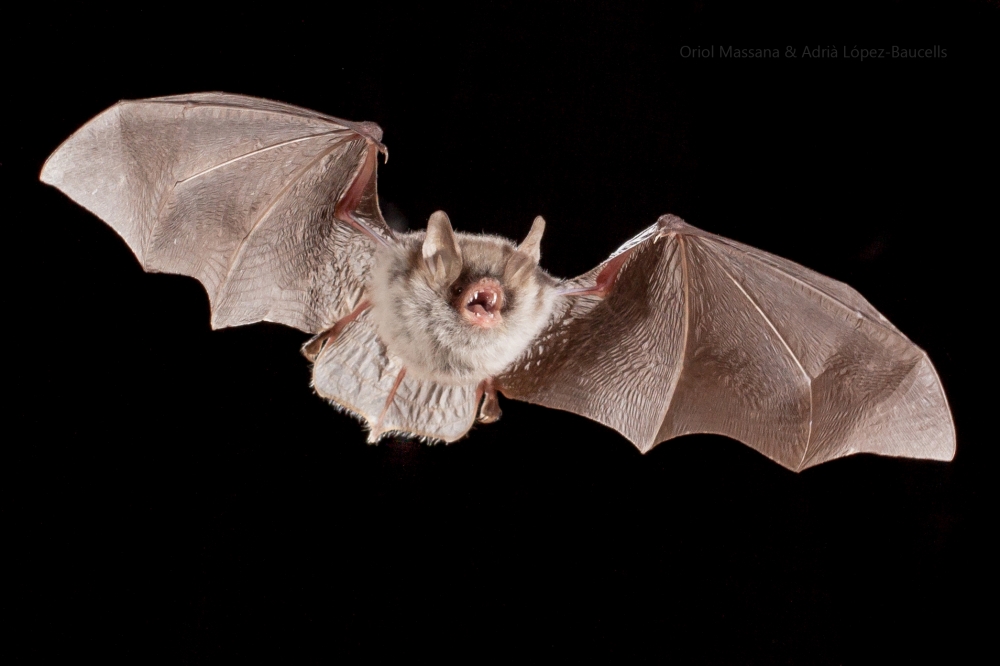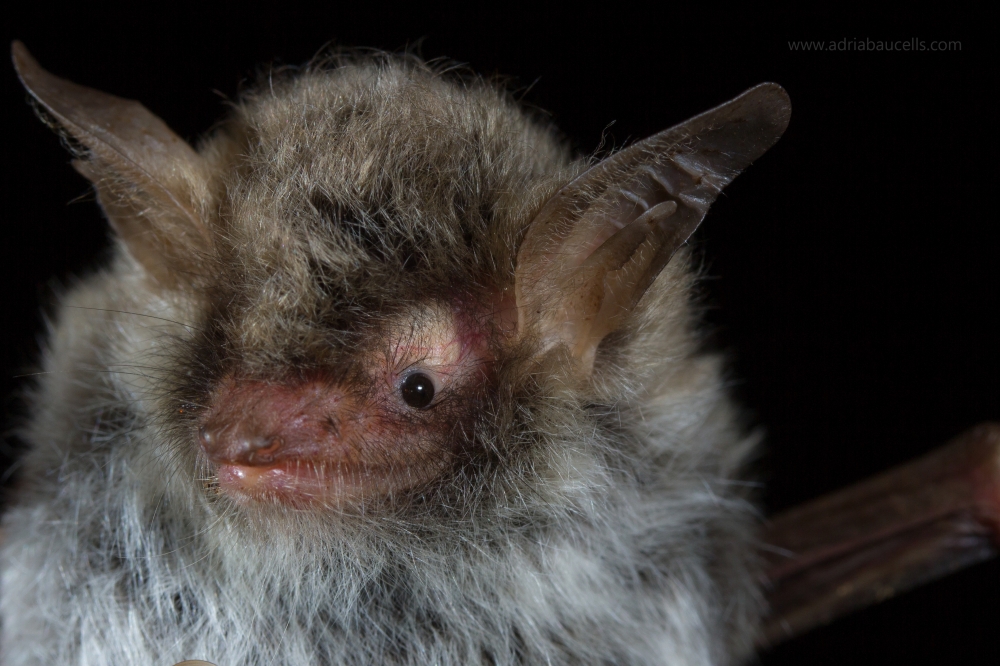Escalera's bat

Myotis escalerai (Cabrera, 1904)
Vespertilionidae
Least Concern
| Other names | |
|---|---|
| Catalan | Rater gris ibèric |
| Spanish | Murciélago ratonero gris ibérico |
| English | Escalera's bat |
| French | Murin de Escalera |
| Basque | Cabrera saguzar |
| Galician | Morcego gris ibérico |
Description
Medium-sized bat with a total length between 42 and 50 mm, forearm between 36.5 and 43 mm, legs between 6.7 and 10 mm, a tail between 42 and 50 mm, and a weight between 4.5 and 9 g. The fur colouration varies between brownish and grayish tones on the dorsal part and more gray or whitish tones on the ventral part. Juveniles tend to be darker than adults. The face has pinkish tones, almost always without fur around the eyes and muzzle. The ears are quite long (between 15 and 18 mm) with the typical pointed tragus of the Myotis genus.
Together with the Cryptic myotis (Myotis crypticus), it is part of a species complex that was previously included in Natterer's bat (Myotis nattereri), the Natterer's complex. It differs from the Cryptic bat by the double fringe of long and rigid hairs on the edge of the tail membrane (uropatagium), with one fringe being twice as long as the other, and the insertion of the wing to the foot is at the metatarsus.
Fotografies
Distribution
It is distributed throughout almost the entire Iberian Peninsula (absent from the wetter areas in the north of the Peninsula), with the upper limit of distribution in the French Pyrenees. It has also been cited in the Balearic Islands.
Roosts and phenology
It is a common species in caves and mines, highly cavernicolous. Despite needing more information, it seems that it primarily takes refuge in cracks and holes within cavities, where it generally goes unnoticed. There is not much information about the reproductive biology of this species. Nevertheless, it is known that breeding colonies can house up to 800 females with pups, often mixed with other cave-dwelling species in caves and mines. Females usually give birth in May and typically have one pup per year, which becomes fully independent by July. Males and solitary individuals can be found in rock crevices, cave ceilings, tunnels, as well as in buildings and bridges.
The high presence of males in caves in September suggests a late swarming behavior. Although there is a lack of information, this species is not considered migratory. Winter hibernation shelters are still largely unknown for this species, although suitable shelters have been observed to be used throughout the year.
Habitat and diet
It has significant ecological plasticity, and therefore, it can be found in various habitats. It can be found in arid lowland areas or shrublands, as well as in mountainous forested areas such as beech forests or pine groves. It can form colonies along a broad altitudinal gradient, from sea level to 1,400 m, although it seems to be found at lower elevations than the Cryptic myotis (Myotis crypticus).
Its diet is believed to consist of insects such as beetles, dipterans, nocturnal lepidopterans, and caterpillars, as well as spiders and other arthropods. Although its hunting habitats are not well known, they are likely to be similar to those of Natterer's bat (Myotis nattereri). The longer hair fringe on the uropatagium suggests a greater reliance on touch to capture prey.
Echolocation
The echolocation of this species is typical of the Myotis genus, with highly modulated calls. However, the calls of this species are characterized by covering a broad range of frequencies, starting at frequencies between 120 and 140 kHz and ending with low frequencies between 15 and 20 kHz. Therefore, acoustically, it is classified in the Myotis 50 phonic group. Recently, it has been observed that bats from the Nattereri complex can be distinguished from other small Myotis in some cases.
Status
According to the IUCN Red List, it is classified as Least Concern with an uncertain population trend. The main threats to this species are related to habitat loss and disturbances in their shelters such as caves and mines. The population in France is around 1,000 individuals, while in Spain, it has been estimated to be around 45,000 individuals, although more information is still needed.


